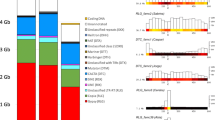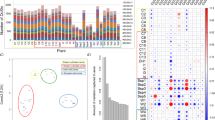Abstract
Mobile elements using a “cut and paste” mechanism of transposition (Class II) are frequently prone to internal deletions and the question of the origin of these copies remains elusive. In this study, we looked for copies belonging to the Lemi Family (Tc1-mariner-IS630 SuperFamily) in the plant genomes, and copies within internal deletions were analyzed in detail. Lemi elements are found exclusively in Eudicots, and more than half of the copies have been deleted. All deletions occur between microhomologies (direct repeats from 2 to 13 bp). Copies less than 500 bp long, similar to MITEs, are frequent. These copies seem to result from large deletions occurring between microhomologies present within a region of 300 bp at both extremities of the element. These regions are particularly A/T rich, compared to the internal part of the element, which increases the probability of observing short direct repeats. Most of the molecular mechanisms responsible for double strand break repair are able to induce deletions between microhomologies during the repair process. This could be a quick way to reduce the population of active copies within a genome and, more generally, to reduce the overall activity of the element after it has entered a naive genome.






Similar content being viewed by others
References
Achaz G, Coissac E, Viari A, Netter P (2000) Analysis of intrachromosomal duplications in yeast Saccharomyces cerevisiae: a possible model for their origin. Mol Biol Evol 17:1268–1275
Anxolabehere D, Benes H, Nouaud D, Periquet G (1987) Evolutionary steps and transposable elements in Drosophila melanogaster: the missing RP type obtained by genetic transformation. Evolution 41:846–853
Auge-Gouillou C, Hamelin MH, Demattei MV, Periquet M, Bigot Y (2001) The wild-type conformation of the Mos-1 inverted terminal repeats is suboptimal for transposition in bacteria. Mol Genet Genomics 265:51–57
Bessereau J-L (2006) Transposons in C. elegans. In: WormBook (ed.) The C. elegans research community. WormBook. doi:10.1895/wormbook.1.70.1, http://www.wormbook.org
Brookfield JFY (1996) Genetic evidence for repression of somatic P element movements in Drosophila melanogaster consistent with a role for the KP element. Heredity 76:384–391
Brunet F, Giraud T, Godin F, Capy P (2002) Do deletions of the Mos1-like elements occur randomly in the Drosophilidae family? J Mol Evol 54:227–234
Capy P, Anxolabehere D, Langin T (1994) The strange phylogenies of transposable elements: are horizontal transfers the only explantation? Trends Genet 10:7–12
Casacuberta E, Casacuberta JM, Puigdomenech P, Monfort A (1998) Presence of miniature inverted-repeat transposable elements (MITEs) in the genome of Arabidopsis thaliana: characterisation of the Emigrant family of elements. Plant J 16:79–85
Cockram J, Mackay IJ, O’Sullivan DM (2007) The role of double-stranded break repair in the creation of phenotypic diversity at cereal VRNI loci. Genetics 177:2535–2539
Daniels SB, Clark SH, Kidwell MG, Chovnick A (1987) Genetics transformation of Drosophila melanogaster with an autonomous P-element: phenotypic and molecular analyses of long-established transformed lines. Genetics 115:711–723
De Aguiar D, Hartl DL (1999) Regulatory potential of nonautonomous mariner elements and subfamily crosstalk. Genetica 107:79–85
Decottignies A (2007) Microhomology-Mediated end joining in fission yeast is repressed by Pku70 and relies on genes involved in homologous recombination. Genetics 176:1403–1415
Dufresne M, Hua-Van A, Abd el Wahab H, Ben M’Barek S, Kerma GHL, Daboussi MJ (2007) Transposition of a fungal MITE through the action of a Tc1-like transposase. Genetics 175:441–452
Feschotte C, Mouches C (2000) Evidence that a family of miniature inverted-repeat transposable elements (MITEs) from the Arabidopsis thaliana genome has arisen from a pogo-like DNA transposon. Mol Biol Evol 17:730–737
Feschotte C, Zhang X, Wessler SR (eds) (2002) Miniature inverted-repeat transposable elements and their relationship to Eetablished DNA transposons. Mobile DNA II. ASM Press, Washington, DC, USA
Feschotte C, Swamy L, Wessler SR (2003) Genome-wide analysis of mariner-like transposable elements in rice reveals complex relationships with Stowaway miniature inverted repeat transposable elements (MITEs). Genetics 163:747–758
Galindo MI, Ladeveze V, Lemeunier F, Kalmes R, Periquet G, Pascual L (1995) Spread of the autonomous transposable element hobo in the genome of Drosophila melanogaster. Mol Biol Evol 12:723–734
Gao CH, Xiao ML, Ren XD, Hayward A, Yin JM, Wu LK, Fu DH, Li JN (2012) Characterization and functional annotation of nested transposable elements in eukaryotic genomes. Genomics 100:222–230
Grover CE, Kim HR, Wing RA, Paterson AH, Wendel JF (2004) Incongruent patterns of local and global genome size evolution in cotton. Genome Res 14:1474–1482
Guermonprez H, Loot C, Casacuberta JM (2008) Different strategies to persist: the pogo-like Lemi1 transposon produces miniature inverted-repeat transposable elements or typical defective elements in different plant genomes. Genetics 180:83–92
Heacock M, Spangler E, Riha K, Puizina J, Shippen DE (2004) Molecular analysis of telomere fusions in Arabidopsis: multiple pathways for chromosome end-joining. EMBO J 23:2304–2313
Hua-Van A, Daviere JM, Kaper F, Langin T, Daboussi MJ (2000) Genome organization in Fusarium oxysporum: clusters of Class II transposons. Curr Genet 37:339–347
Izsvak Z, Stuwe EE, Fiedler D, Katzer A, Jeggo PA, Ivics Z (2004) Healing the wounds inflicted by Sleeping Beauty transposition by double-strand break repair in mammalian somatic cells. Mol Cell 13:279–290
Jacobson JW, Hartl DL (1985) Coupled instability of two X-linked genes in Drosophila mauritiana: germinal and somatic instability. Genetics 111:57–65
Jacobson JW, Medhora MM, Hartl DL (1986) Molecular structure of a somatically unstable transposable element in Drosophila. Proc Natl Acad Sci USA 83:8684–8688
Jiang N, Feschotte C, Zhang XY, Wessler SR (2004) Using rice to understand the origin and amplification of miniature inverted repeat transposable elements (MITEs). Curr Opin Plant Biol 7:115–119
Koga A, Sasaki S, Naruse K, Shimada A, Sakaizumi M (2011) Occurrence of a short variant of the Tol2 transposable element in natural populations of the medaka fish. Genet Res 93:13–21
Ladeveze V, Galindo I, Chaminade N, Pascual L, Periquet G, Lemeunier F (1998) Transmission pattern of hobo transposable element in transgenic lines of Drosophila melanogaster. Genet Res 71:97–107
Le Rouzic A, Capy P (2005) The first steps of transposable elements invasion: parasitic strategy vs. genetic drift. Genetics 169:1033–1043
Le Rouzic A, Boutin TS, Capy P (2007) Long-term evolution of transposable elements. Proc Natl Acad Sci USA 104:19375–19380
McVey M, Lee SE (2008) MMEJ repair of double-strand breaks (director’s cut): deleted sequences and alternative endings. Trends Genet 24:529–538
Puchta H (2005) The repair of double-strand breaks in plants: mechanisms and consequences for genome evolution. J Exp Bot 56:1–14
Rouault JD, Casse N, Chenais B, Hua-Van A, Filee J, Capy P (2009) Automatic classification within families of transposable elements: Application to the mariner Family. Gene 448:227–232
Rubin E, Levy AA (1997) Abortive gap repair: underlying mechanism for Ds element formation. Mol Cell Biol 17:6294–6302
SanMiguel P, Tikhonov A, Jin YK, Motchoulskaia N, Zakharov D, Melake-Berhan A, Springer PS, Edwards KJ, Lee M, Avramova Z, Bennetzen JL (1996) Nested retrotransposons in the intergenic regions of the maize genome. Science 274:765–768
Scavarda NJ, Hartl DL (1987) Germ line abnormalities in Drosophila simulans transformed with the transposable P-element. J Genet 66:1–15
Soltis DE, Soltis PS, Chase MW, Mort ME, Albach DC, Zanis M, Savolainen V, Hahn WH, Hoot SB, Fay MF, Axtell M, Swensen SM, Prince LM, Kress WJ, Nixon KC, Farris JS (2000) Angiosperm phylogeny inferred from 18S rDNA, rbcL, and atpB sequences. Bot J Linn Soc 133:381–461
The Angiosperm Phylogeny Group (2003) An update of the Angiosperm Phylogeny Group classification for the orders and families of flowering plants: APG II. Bot J Linn Soc 141:346–399
Wicker T, Sabot F, Hua-Van A, Bennetzen JL, Capy P, Chalhoub B, Flavell A, Leroy P, Morgante M, Panaud O, Paux E, SanMiguel P, Schulman AH (2007) A unified classification system for eukaryotic transposable elements. Nat Rev Genet 8:973–982
Yang GJ, Nagel DH, Feschotte C, Hancock CN, Wessler SR (2009) Tuned for transposition: molecular determinants underlying the hyperactivity of a Stowaway MITE. Science 325(5946):1391–1394
Yant SR, Kay MA (2003) Nonhomologous-end-joining factors regulate DNA repair fidelity during Sleeping Beauty element transposition in mammalian cells. Mol Cell Biol 23(23):8505–8518
Yu AM, McVey M (2010) Synthesis-dependent microhomology-mediated end joining accounts for multiple types of repair junctions. Nucleic Acid Res 38:5706–5717
Yu JH, Marshall K, Yamaguchi M, Haber JE, Weil CF (2004) Microhomology-dependent end joining and repair of transposon-induced DNA hairpins by host factors in Saccharomyces cerevisiae. Mol Cell Biol 24:1351–1364
Author information
Authors and Affiliations
Corresponding author
Electronic supplementary material
Below is the link to the electronic supplementary material.
10709_2013_9736_MOESM1_ESM.pdf
Supplementary data - Figure 1: Phylogeny of Lemi copies belonging to the papilionis Tribe. The minimum size of the copies is 2,035 bp. The phylogeny was constructed using the Neighbor-Joining method (default parameters, bootstrap with 1,000 replications) of MEGA. (PDF 57 kb)
10709_2013_9736_MOESM2_ESM.pdf
Supplementary data – Figure 2: Dotplot of mariner and Lemi elements of M. truncaluta (MtLemi1) and A. thaliana (AtLemi1) against themselves using dotmatcher of EMBOSS. (PDF 464 kb)
Rights and permissions
About this article
Cite this article
Negoua, A., Rouault, JD., Chakir, M. et al. Internal deletions of transposable elements: the case of Lemi elements. Genetica 141, 369–379 (2013). https://doi.org/10.1007/s10709-013-9736-3
Received:
Accepted:
Published:
Issue Date:
DOI: https://doi.org/10.1007/s10709-013-9736-3




